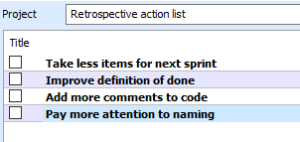You have just completed a sprint and are on your way to the retrospective. In a flash you remember you all agreed to do something about X. The mail from the Scrum Master with the retro’s action list, still sits in your inbox.
Sound familiar? Then I have good news for you. There’s a better way.
Ditch your retrospective action list!
Don’t ditch making improvements. Just ditch the action list.
Action list problems
Action lists suffer the same problems as a backlog used as a souvenir cabinet and to do list. Any list of that type, actually.
Unless you actually categorize, size and prioritize what’s on your to do list (sound familiar?), and regularly cull items that are no longer relevant, your to do list will only lead to overwhelm, frustration and confusion.
41% of items on such lists never are completed)! The most successful and productive people don’t use to do lists. So why do we?
Scrum Guide
But action lists are required by the Scrum Guide, aren’t they?
You would say so if you look at various presentations about retrospectives, but…
Actually, no. No. Yes, you heard me right. N. o. No.
The Scrum Guide only says that the team must identify improvements that will be implemented in the next sprint:
By the end of the Sprint Retrospective, the Scrum Team should have identified improvements that it will implement in the next Sprint. Implementing these improvements in the next Sprint is the adaptation to the inspection of the Scrum Team itself. Although improvements may be implemented at any time, the Sprint Retrospective provides a formal opportunity to focus on inspection and adaptation.
Focus, concentrate
Okay, so if we don’t use an action list, what do we do?
Decide which of all the suggestions for improvement made during the retrospective, will have the most impact and can be worked on now. Concentrate on that single improvement. Even if it is something that can’t be completed in a single sprint. In that case, figure out what first steps can be taken towards the desired improvement now. And focus on those.
Disregard all the other improvement suggestions. Be ruthless. Ignore them. Don’t add them to any list at all.
Don’t worry about forgetting them. If they were good improvements, they will not be forgotten. They will re-appear as if they had never been ignored, in a subsequent retrospective.
Now, you have a single improvement to concentrate on. One that you actually can implement (at least take steps towards that) in the next sprint (a requirement which is in the Scrum Guide).
Keep everybody’s attention on it
A single improvement, even if it will take a couple of steps, is easy to keep at the forefront of everyone’s mind: simply include it in your daily stand-up.
If it is something that needs to be created or changed – like a change to your build process – talk about what has been finished and what will be done (and by whom) today.
If it is more about a change in behavior – like asking for help before you are drowning – mention it at the start of the stand-up to remind everyone of what is expected from them.
Don’t forget to celebrate each step that brings the improvement closer. Change to the build implemented and working successfully? Celebrate! Someone ask for help before drowning? Celebrate!
When you go about improving in this manner, you will improve more and faster, than using a list of stuff that is forgotten as soon as everyone returns to their normal day-to-day tasks.
How many items are on your team’s retrospective action list? What’s the one with the most impact? What can you do today towards the desired improvement?












Leave a Reply